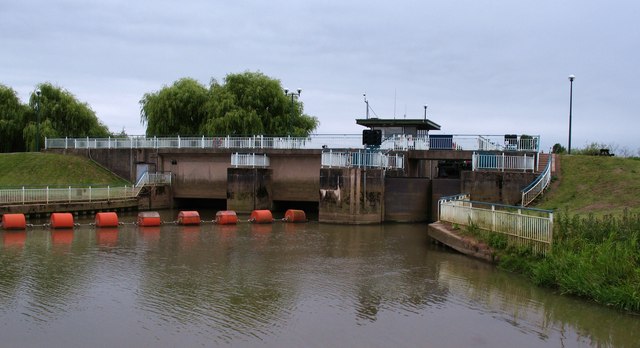Barrage
|
The Barmby tidal barrage is shown at the point where the Derwent meets the Ouse. The barrage was constructed in 1974 to prevent tidal water entering the Derwent and causing flooding. |
Contents |
[edit] Introduction
The International Levee Handbook, published by CIRIA in 2013, defines barrage as a: "Structure built in an estuary with the specific intention of preventing, or in some way modifying, tidal propagation.”
[edit] Types of barrages
[edit] Tidal barrage
A barrage may also be referred to as an estuary barrier or coastal barrier. It may be constructed to assist with irrigation or it can generate hydroelectricity by harnessing tidal power. These types of barrages may be referred to as tidal barrages.
[edit] Barrage dam
Barrages that are used as diversion dams (sometimes referred to as barrage dams) may be controlled by gates that are opened or closed in order to control water levels. The gates are constructed between piers that are used to control the load and pressure of the contained water.
Barrage dams are frequently constructed near the mouth of large, winding rivers. They are generally built on flat terrain.
Barrage dams primarily divert water and tend to raise water levels by relatively small amounts (such as one metre). Unlike conventional dams, they do not hold large amounts of water in reservoirs.
[edit] Related articles on Designing Buildings Wiki
Featured articles and news
RTPI leader to become new CIOB Chief Executive Officer
Dr Victoria Hills MRTPI, FICE to take over after Caroline Gumble’s departure.
Social and affordable housing, a long term plan for delivery
The “Delivering a Decade of Renewal for Social and Affordable Housing” strategy sets out future path.
A change to adoptive architecture
Effects of global weather warming on architectural detailing, material choice and human interaction.
The proposed publicly owned and backed subsidiary of Homes England, to facilitate new homes.
How big is the problem and what can we do to mitigate the effects?
Overheating guidance and tools for building designers
A number of cool guides to help with the heat.
The UK's Modern Industrial Strategy: A 10 year plan
Previous consultation criticism, current key elements and general support with some persisting reservations.
Building Safety Regulator reforms
New roles, new staff and a new fast track service pave the way for a single construction regulator.
Architectural Technologist CPDs and Communications
CIAT CPD… and how you can do it!
Cooling centres and cool spaces
Managing extreme heat in cities by directing the public to places for heat stress relief and water sources.
Winter gardens: A brief history and warm variations
Extending the season with glass in different forms and terms.
Restoring Great Yarmouth's Winter Gardens
Transforming one of the least sustainable constructions imaginable.
Construction Skills Mission Board launch sector drive
Newly formed government and industry collaboration set strategy for recruiting an additional 100,000 construction workers a year.
New Architects Code comes into effect in September 2025
ARB Architects Code of Conduct and Practice available with ongoing consultation regarding guidance.
Welsh Skills Body (Medr) launches ambitious plan
The new skills body brings together funding and regulation of tertiary education and research for the devolved nation.
Paul Gandy FCIOB announced as next CIOB President
Former Tilbury Douglas CEO takes helm.
UK Infrastructure: A 10 Year Strategy. In brief with reactions
With the National Infrastructure and Service Transformation Authority (NISTA).























